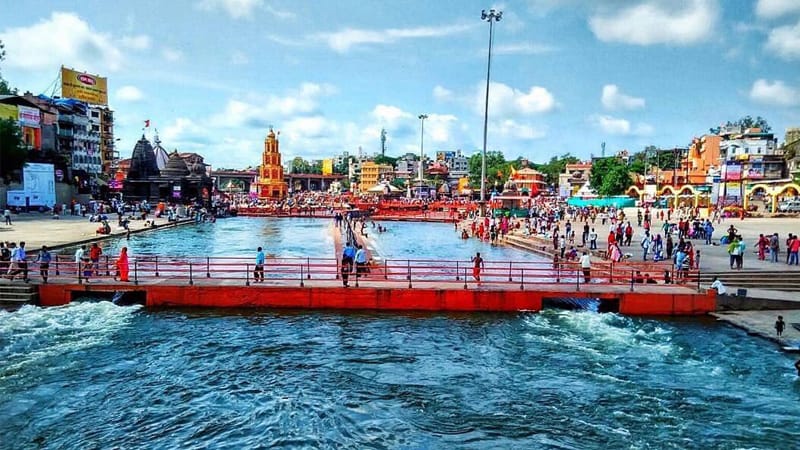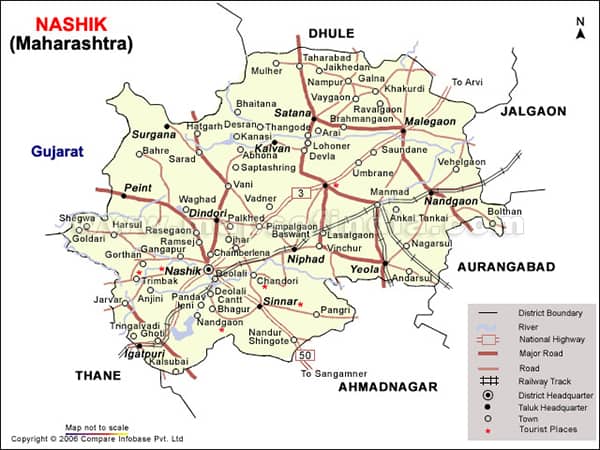
- 18 November 2021
Nashik, commonly known as Nasik, is a historic city and the largest city in the northern part of Maharashtra, India. Nashik, Maharashtra's fourth-largest city after Mumbai, Pune, and Nagpur, is located on the banks of the Godavari River. Nashik is well-known as a Hindu pilgrimage destination for the Kumbh Mela, which occurs every 12 years. Nashik is somewhere around 190 kilometres north from the state capital, Mumbai, the state capital. Because it is home to more than half of India's vineyards and wineries, the city is regarded as the "Wine Capital of India." The Nashik Valley produces over 90% of all wine produced in India. Nashik is one of India's fastest-growing cities. In addition, it has been an important industrial centre in the automobile world.
Nashik Geography

Nashik is located in Maharashtra's northern region, at the height of 584 metres (1,916 feet) above sea level, which allows for excellent temperature variance, especially during the winter months. Nashik is situated on the western edge of the Deccan Plateau, an ancient volcanic formation. The source for the Godavari River is located around 30 kilometres (19 miles) from the city and is known as Trimbakeshwar. The geographical area of the city is approximately 259.13 km2 (100.05 sq mi).
Nashik Weather
Thanks to its tropical location and high altitude, the city enjoys a comparatively mild tropical wet and dry climate. During the cooler season between November and February, temperatures drop a bit with highs of approximately 28°C but cool off with lows of around 10°C at night. The moisture-rich wet season kicks in during April and lasts until September — this is when the area gets more than 1,000 mm of rain on average.
Nashik Demographics
After Mumbai, Pune, and Nagpur, Nashik is the fourth most populous city in Maharashtra. Nashik had a population of 1,486,053 people in 2011, according to the Indian Census. Males make up 782,517 of the people, while females make up 703,536. The population of metropolitan Nashik was 1,561,809 people, with 821,921 men and 739,888 women. The average literacy rate in Nashik was 89.85 per cent, with male literacy at 93.40 per cent and female literacy at 85.92 per cent.
Although Nashik has a population of 1,486,053, the city's urban / metropolitan population is 1,561,809 people, with 821,921 men and 739,888 women. Nashik's sex ratio is 894 men per 1,000 females. The girl-to-boy ratio is 865 for every 1,000 males. 11.42 per cent of Nashik's population is under the age of six.
Nashik Agriculture
In Nashik, there is a grape vineyard. Raosaheb Jairam Krishna Gaikwad began the table grape revolution in Ojhar, a tiny hamlet near Nashik, in early 1925. Table grapes are now shipped to Europe, the Middle East, and Asia, among other places.
On average, kharif crops cover 663,200 hectares, whereas Rabbi crops cover 136,500 hectares. The total planted area is 658,763 hectares (99 per cent), with 340,000 hectares of forest land (21.75 per cent). A total of 23,000 hectares are uncultivable (1.48 per cent).
Industry of Wine
Nashik is home to the largest grape production in India, with 10,000 tonnes grown annually. As a result, the city has earned the nickname "India's Wine Capital.
There were 22 wineries in Nashik in 2013, out of 46 throughout India. The Sula Vineyards are Nashik's largest vineyard. Having the world's biggest vineyard isn't just about a bragging right. It gives India the ability to experiment with varieties and winemaking techniques, all of which will affect India's wine industry — whether it's a new harvest season or a new type of wine. Adding to the quality of Indian wines, there are festivals all year round in Nashik — some celebrating the grape harvest, and others simply celebrating wine and its culture.
Kumbh Mela is an annual religious festival held in India.

Kumbh Mela is one of India's most exhilarating festivals, attracting more than 100 million people every three years. In Allahabad, Haridwar, Ujjain and Nashik, every 12 years, it is known as the 'Maha Kumbh Mela'. Along with millions of other devout Hindus, millions of devotees gather at these four places to bathe in the waters of the Ganga River.
The Business Hub For Big Names
Nashik is one of the fastest-growing cities in India, and it houses popular companies like Atlas Copco, Robert Bosch GmbH, CEAT Limited, Crompton Greaves, Graphite India, ThyssenKrupp, Epcos, Everest Industries, GlaxoSmithKline and Hindustan Unilever Limited.
Holy Place
According to the Ramayana, Nashik is the spot on the banks of the Godavari River where Laxman, at Lord Rama's request, chopped the nose of the demon Shurpanakha, thus the name "Nashik." It's also referred to as Panchavati.
Nashik Municipal Corporation NMC

The Nashik Municipal Corporation is in charge of the bringing and keeping of the city of Nashik. The city is a district headquarters situated on the banks of the river Godavari somewhere 185 kilometres (115 miles) from Mumbai. The city has grown on both sides of the Godavari River, splitting the city into nearly equal halves.
Kailas Jadhav is heading the Municipal Corporation as the Commissioner of Nashik. The ward committee comprises councillors who represent the electoral wards within the ward committee's geographical territory. The committees' major job is to approve the work cost for the wards, include costs in the budget, and so on.



